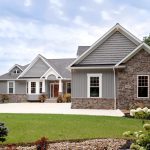We’ve been hearing a lot these days about the rising cost of housing – not just affordable housing for low-income families but affordable workforce housing for educators, first responders and other skilled workers. It should kill us that these brothers, sisters, parents, friends and neighbors who are essential to our communities have been priced out of the American dream of owning a home.
But what is equally upsetting is that nobody is talking about one key factor driving the cost of housing up: local bans from municipal governments on cost-effective materials that force home builders to use more expensive exteriors like brick.
Yes, we get that the rising cost of materials and the labor shortage are major contributing factors to this crisis. But putting unfair and “un-American” restrictions on the home buyers’ ability to select the most cost-effective materials for their new home – whether it’s a new construction or a renovation of a “fixer-upper” – is a major deal-breaker, especially when you consider that vinyl siding could be the ultimate solution to soldiering through this predicament.
The Proof is in the Pudding
Vinyl siding has the lowest installed cost of any cladding in the home building industry and outperforms the competition in energy efficiency, performance, and hence, lifespan. This side-by-side comparison from Todayshomeowner.com says it all:
Vinyl siding is the most affordable choice of all the exteriors. While aluminum may be competitive in price, its performance life is 35 years, whereas vinyl siding lasts 50-75 years.
In addition to its superior price points, vinyl siding is also four times more energy-efficient than all other claddings, It is arguably the most climate-resilient and the most sustainable (which qualifies your new home project for rebates, green credits and future savings on utility costs).

Local Bans: VSI Continues to Fight for Change
Over the past five years, the Vinyl Siding Institute’s (VSI) advocacy team has been a powerful resource for influencing legislative reform in key states where the homebuilding industry has been thriving. These states include North Carolina, Tennessee, Arkansas, Oklahoma and Texas.
A bill was introduced in Georgia that VSI was hoping to pass this year, but strong resistance from the brick industry has delayed a possible vote until 2024. Thus, instead of paying less than $6 per square foot for your new home, you may be forced to pay well over $30 per square foot if the bricklayers have their way in a state where the median price for a home is $367,000 and new home prices continue to rise by more than 10%.
Local bans on vinyl siding and other modern materials also have a negative impact on one of the fastest-growing trends in affordable workforce homebuilding – modular construction. Shifting construction tasks from the job site to a controlled factory environment, modular construction is an eco-friendly solution in which prefabricated sections of a home are assembled with greater precision, faster project delivery and significantly reduced waste. It’s no surprise that vinyl siding is among the top cladding options selected for modular home designs.
Education Is Key
In addition to working at the state level with key stakeholders to influence legislative reform, VSI’s advocacy efforts also extend to education.
VSI recently hosted the webinar, Housing Affordability & the Impact of Aesthetic Mandates on Individual Choice, presented by Minnesota State Representative and Minority Whip Jim Nash (R-48A) and Alex Fernandez, VSI’s Senior Director of Advocacy in November. It was a deeper dive into the negative impacts of these rigid mandates on housing accessibility. For guidance on addressing aesthetic mandates in your state, contact VSI’s Senior Director of Advocacy Alex Fernandez at afernandez@polymericexteriors.com.
_____________________________________________________________________________________________________________________
Don Browne is a writer, entrepreneur and local legislator who believes that the power of words can change the world. He provides unique writing services for clients in the construction, health care, IT and hospitality sectors. He has a passion for small business and start-ups, as well as writing about Irish history, family and corporate biographies. As a homeowner and father of four who is passionate about community development, Don looks forward to writing more about the exciting possibilities of creating traditional neighborhoods and more sustainable communities using modern materials.
